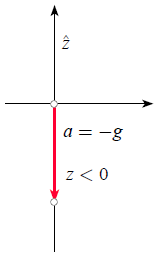Gravitation
Storyboard 
To describe how speed evolves over time, the variation in time must be studied.
The speed variation ratio is equivalent to the curvature of the path traveled in the elapsed time which, divided by this, corresponds to the acceleration.
For a finite elapsed time the speed corresponds to the average acceleration during that time.
ID:(1383, 0)
Gravity with Axis pointing down
Definition 
When using a coordinate system with positive z-axis pointing upwards, gravity corresponds to a process of acceleration in the downward direction:

Gravity with axis pointing down
ID:(2249, 0)
Gravity with Axis pointing up
Image 
When using a coordinate system with negative z-axis pointing downwards, gravity corresponds to a process of acceleration in the same direction as the z-axis:

Gravity with axis pointing up
ID:(2250, 0)
Gravitation
Description 
To describe how speed evolves over time, the variation in time must be studied. The speed variation ratio is equivalent to the curvature of the path traveled in the elapsed time which, divided by this, corresponds to the acceleration. For a finite elapsed time the speed corresponds to the average acceleration during that time.
Variables
Calculations
Calculations
Equations
Examples
When using a coordinate system with positive z-axis pointing upwards, gravity corresponds to a process of acceleration in the downward direction:

Gravity with axis pointing down
(ID 2249)
When using a coordinate system with negative z-axis pointing downwards, gravity corresponds to a process of acceleration in the same direction as the z-axis:

Gravity with axis pointing up
(ID 2250)
ID:(1383, 0)
